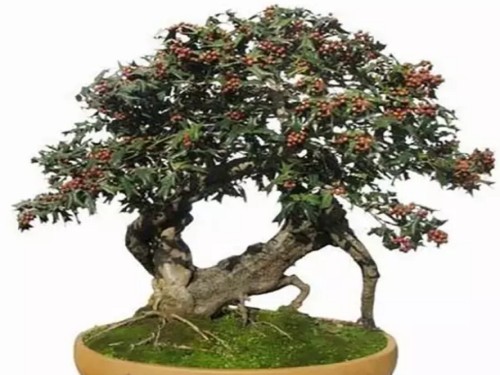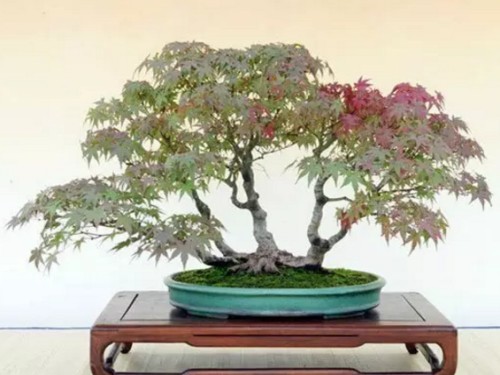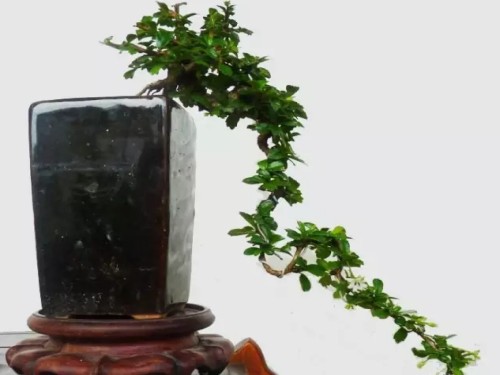The method of making bonsai with Chinese wolfberry
The branches of Chinese wolfberry are dense, the leaves are peculiar, and the red fruits are bright in autumn. it is an excellent tree species for viewing leaves and fruits. Old pile bonsai posture is quaint, evergreen all the year round, suitable for viewing all the year round. Decorative applications can be cultivated as hedges in the courtyard, or potted, displayed in the hall, placed on several shelves, because there are thorns not to be touched by children, so as to avoid injury.
In today's society, more and more people like to enjoy bonsai, not only beautify their homes, but also purify the air, so, do you know bonsai? Today, let's take a look at the method of making bonsai with you.

[material selection and cultivation measures]
Artificial propagation: mainly by sowing and propagation, but also by cutting and tillering.
The fruit was ripe in November, piled up after harvest, pounded after the peel was softened, rinsed and taken out. The seeds of Chinese wolfberry should be germinated for 2 years and can be treated with low temperature and wet sand for one year and mixed every two months during sand storage to maintain a certain humidity and prevent the seeds from deteriorating. The seeds are sown in winter, with a row spacing of 15-20 cm, a depth of 2-3 cm, covered with scorched mud of 1.5 cm, and then covered with straw.
It can be unearthed in March, uncover the grass in time and build a shed for shade. Usually pay attention to watering, topdressing, weeding and loosening soil and other management work, the growth of seedlings is slow, stay in bed for 1-2 years and then split.
Cutting propagation in mid-late June (Meiyu season) selected the current year's semi-mature branches as cuttings, length to be able to heel (with some of last year's old branches) for the degree, leaving leaves 4-6, cutting depth 12-23, watering after planting, shade, watering frequently, BB to keep the soil moist. After rooting, strengthen the management of seedling stage, stay in bed for 1-2 years and then transplant, the survival rate of spring migration is higher. Some of the roots can be dug up and propagated by tillers.
Mountain mining: wild Chinese wolfberry plants are often found in the mountain ditches in the middle and lower reaches of the Yangtze River basin, which can be selected to grow old piles for many years, trim the main roots after digging back, protect the lateral roots, cultivate them in shade and moist places, and wait for the root system to develop and new branches to germinate. and then on the basin processing shape, can be made into quaint and strange foliage bonsai.
Bonsai with Chinese wolfberry
[process of putting on the basin]
Selection of pots: glazed pottery pots or purple sand pottery pots for medlar bone are suitable, and stone chiseling basins can be used. Because the leaf is dense, the leaf color is thick green, so the basin color should avoid choosing the dark green type, otherwise it is close to the leaf color and can not play the role of contrast. It is better to use a rectangle, a square or a waist circle in a basin shape. Bonsai is often made of glazed pottery or purple sand pottery, or chiseled stone basins; the potted colors can be exposed with purple, blue, light yellow and gray; dark green should not be used, because the color is similar to that of the leaves. The basin shape can be rectangular, square, round waist and round drum.
Use soil: it is appropriate to use fertile, loose, permeable soil, slightly acidic, neutral or calcareous soil. Potted plants can use rotten leaf soil and pastoral soil, mixed with appropriate amount of sand.
Planting: should be done after autumn or before sprouting in spring. As the lateral root of Chinese wolfbone is well developed, but the fibrous root is less, it is best to take a soil ball to protect the fibrous root and prune the branches and leaves properly at the same time.
[orthostatic technique]
Processing: Chinese wolfberry leaves have sharp thorns, inconvenient processing. Can first cut off all kinds of unnecessary branches and leaves, and then the remaining branches for climbing, and combined with pruning. Because of its large and hard leaves, it is generally not metal wire climbing, but brown wire climbing is better. Processing should be carried out in the rainy season.
Tree shape: medlar bone is suitable for straight dry type, oblique dry type, curved dry type and cliff type and so on. The branches and leaves of large bonsai can be made into pieces, while the small ones are better made in natural style. Tree stump bonsai should highlight the beauty of exposed roots and dry posture.
Shape: the branches of Chinese wolfberry are hard and brittle, usually in the plum rain season, when the sap flow is exuberant. Because of its large and hard leaves, it is generally better to use brown wire climbing, not with metal wire climbing, otherwise it is easy to cause branch and leaf damage. The stiff leaves are hard and sharp. In modeling, the unnecessary branches and leaves can be cut off first, and the rest of the branches can be clamped and trimmed. The tree shape of Chinese wolfbone can be made into straight type, oblique dry type, curved type and cliff type and so on. Small bonsai is better in natural style, large bonsai can tie the branches and leaves into clouds, and the ancient pile scenery appears with the beauty of hanging root and bending dry style.
Time: 2019-05-26 Click:
- Prev

Making method of Maple Bonsai
There are many maples in the wild, and bonsai is often made to dig up old stakes or young trees in the mountains. The new maple branches are long and soft and can be tied into various styles of bonsai. The common ones are direct dry type, oblique dry type, curved dry type, double dry type and water-facing type. Maple trees are mainly shaped by scissors and supplemented by pruning. Maple leaves are larger
- Next

Production Technology of Fujian Tea Bonsai
Fujian tea also known as base and tree, cat tree, for Shikoku evergreen shrubs. Leaves small, long oval, dark green and shiny. Spring and summer open white floret, drupe globose, early green after red. It trunk craggy, Qiuqu diversity, tree posture elegant, Lingnan is one of the four major bonsai species
Related
- Fuxing push coffee new agricultural production and marketing class: lack of small-scale processing plants
- Jujube rice field leisure farm deep ploughing Yilan for five years to create a space for organic food and play
- Nongyu Farm-A trial of organic papaya for brave women with advanced technology
- Four points for attention in the prevention and control of diseases and insect pests of edible fungi
- How to add nutrient solution to Edible Fungi
- Is there any good way to control edible fungus mites?
- Open Inoculation Technology of Edible Fungi
- Is there any clever way to use fertilizer for edible fungus in winter?
- What agents are used to kill the pathogens of edible fungi in the mushroom shed?
- Rapid drying of Edible Fungi

